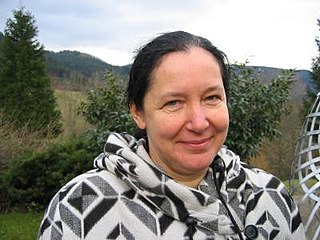
Algebraic topology is a branch of mathematics that uses tools from abstract algebra to study topological spaces. The basic goal is to find algebraic invariants that classify topological spaces up to homeomorphism, though usually most classify up to homotopy equivalence.
In mathematics, specifically in homology theory and algebraic topology, cohomology is a general term for a sequence of abelian groups, usually one associated with a topological space, often defined from a cochain complex. Cohomology can be viewed as a method of assigning richer algebraic invariants to a space than homology. Some versions of cohomology arise by dualizing the construction of homology. In other words, cochains are functions on the group of chains in homology theory.

In mathematics, a topological group G is called a discrete group if there is no limit point in it. Equivalently, the group G is discrete if and only if its identity is isolated.
In mathematics, a Galois module is a G-module, with G being the Galois group of some extension of fields. The term Galois representation is frequently used when the G-module is a vector space over a field or a free module over a ring in representation theory, but can also be used as a synonym for G-module. The study of Galois modules for extensions of local or global fields and their group cohomology is an important tool in number theory.
Algebraic K-theory is a subject area in mathematics with connections to geometry, topology, ring theory, and number theory. Geometric, algebraic, and arithmetic objects are assigned objects called K-groups. These are groups in the sense of abstract algebra. They contain detailed information about the original object but are notoriously difficult to compute; for example, an important outstanding problem is to compute the K-groups of the integers.
In mathematics, in the subfield of geometric topology, the mapping class group is an important algebraic invariant of a topological space. Briefly, the mapping class group is a certain discrete group corresponding to symmetries of the space.
Motivic cohomology is an invariant of algebraic varieties and of more general schemes. It is a type of cohomology related to motives and includes the Chow ring of algebraic cycles as a special case. Some of the deepest problems in algebraic geometry and number theory are attempts to understand motivic cohomology.
In mathematics, complex cobordism is a generalized cohomology theory related to cobordism of manifolds. Its spectrum is denoted by MU. It is an exceptionally powerful cohomology theory, but can be quite hard to compute, so often instead of using it directly one uses some slightly weaker theories derived from it, such as Brown–Peterson cohomology or Morava K-theory, that are easier to compute.

In mathematical group theory, the Schur multiplier or Schur multiplicator is the second homology group of a group G. It was introduced by Issai Schur (1904) in his work on projective representations.
In mathematics, the homotopy category is a category built from the category of topological spaces which in a sense identifies two spaces that have the same shape. The phrase is in fact used for two different categories, as discussed below.
In mathematics, equivariant cohomology is a cohomology theory from algebraic topology which applies to topological spaces with a group action. It can be viewed as a common generalization of group cohomology and an ordinary cohomology theory. Specifically, the equivariant cohomology ring of a space with action of a topological group is defined as the ordinary cohomology ring with coefficient ring of the homotopy quotient :
Tudor Ganea was a Romanian-American mathematician, known for his work in algebraic topology, especially homotopy theory. Ganea left Communist Romania to settle in the United States in the early 1960s. He taught at the University of Washington.
In mathematics and specifically in topology, rational homotopy theory is a simplified version of homotopy theory for topological spaces, in which all torsion in the homotopy groups is ignored. It was founded by Dennis Sullivan (1977) and Daniel Quillen (1969). This simplification of homotopy theory makes certain calculations much easier.

Eva Bayer-Fluckiger is a Hungarian and Swiss mathematician. She is an Emmy Noether Professor Emeritus at École Polytechnique Fédérale de Lausanne. She has worked on several topics in topology, algebra and number theory, e.g. on the theory of knots, on lattices, on quadratic forms and on Galois cohomology. Along with Raman Parimala, she proved Serre's conjecture II regarding the Galois cohomology of a simply-connected semisimple algebraic group when such a group is of classical type.
In mathematics, more precisely, in the theory of simplicial sets, a simplicial group is a simplicial object in the category of groups. Similarly, a simplicial abelian group is a simplicial object in the category of abelian groups. A simplicial group is a Kan complex. The Dold–Kan correspondence says that a simplicial abelian group may be identified with a chain complex. In fact it can be shown that any simplicial abelian group is non-canonically homotopy equivalent to a product of Eilenberg–MacLane spaces,
In topology, a branch of mathematics, a nilpotent space, first defined by Emmanuel Dror (1969), is a based topological space X such that
This is a glossary of properties and concepts in algebraic topology in mathematics.
Chern's conjecture for affinely flat manifolds was proposed by Shiing-Shen Chern in 1955 in the field of affine geometry. As of 2018, it remains an unsolved mathematical problem.



